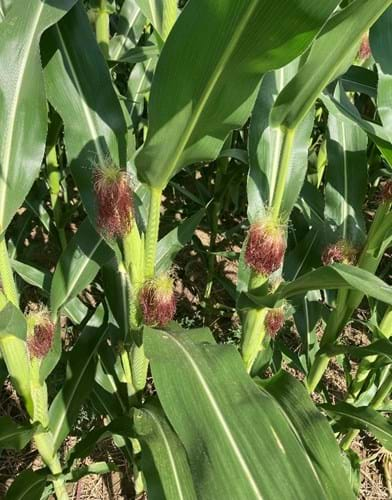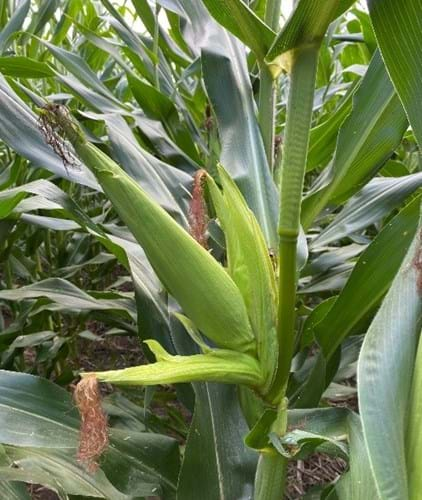Multiple Ears on Corn Plants
BY Dairyland Seed Agronomy Team
The Dairyland Agronomy Team has had a few questions about corn plants producing more than one ear. Although our modern hybrids generally produce one main ear per plant, it is not unusual to find two ears per plant. Favorable growing conditions may result in more than one ear per stalk. The additional ear(s) usually develop on separate nodes below the primary ear and are almost always smaller than the primary ear (see Figure 1). As long as the primary ear is still developing normally there is nothing to worry about since the plant will continue to prioritize the primary ear.
A more uncommon sight is the development of multiple ears on the same node (see Figure 2). This phenomenon is referred to as multiple ears per node, bouquet ears and MESS Syndrome (Multiple Ears on Same Shank). These ears usually experience stunting, abnormal growth and pollination issues which can negatively impact yield. The yield impact can vary greatly depending on if one ear is more dominant than the rest, how many ears are formed at the same node, and how many plants are affected.
 Figure 1. The primary ear on the top node and secondary ear developed on the node below
Figure 1. The primary ear on the top node and secondary ear developed on the node below

Figure 2. Multiple ears developed on the same node.
Although the cause is unknown, researchers have identified some common links with this phenomenon.
- One common factor is when the primary ear was damaged, failed to develop or didn’t pollinate correctly which results in the loss of apical dominance. The plant uses hormonal apical dominance to suppress more than one ear from forming on a node.
- Another link is when the plant endures stress during early ear formation (around V5-V7 timing) which can cause developmental issues with the ear and eventually loss in apical dominance. Some of the early stressors to watch out for include wide temperature fluctuations including exposure to cool temperatures, high winds, flooding or drought stress.
- There is not an obvious link between applications and/or application timing of herbicides, insecticides or fungicides and the development of multiple ears on a node. There is also no conclusive link to specific hybrids or germplasm.
If you have any questions, please reach out to your local Dairyland Seed DSM or Agronomist.
 |
 |
 |
 |
 |
| Brian Weller Western Region 507.456.3034 |
Dan Ritter Central Region 219.863.0583 |
Branden Furseth Northern Region 608.513.4265 |
Mark Gibson Eastern Region 260.330.8968 |
Amanda Goffnett Eastern Region 989.400.3793 |
